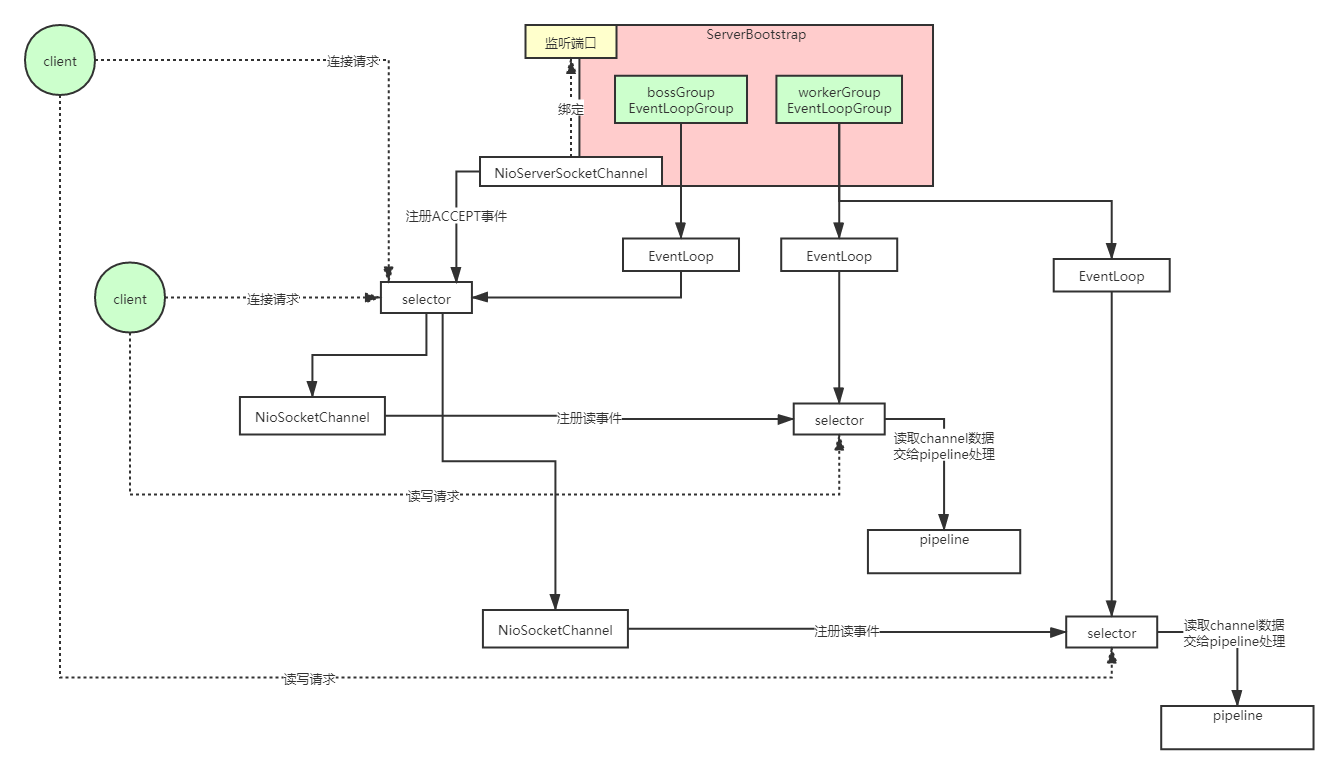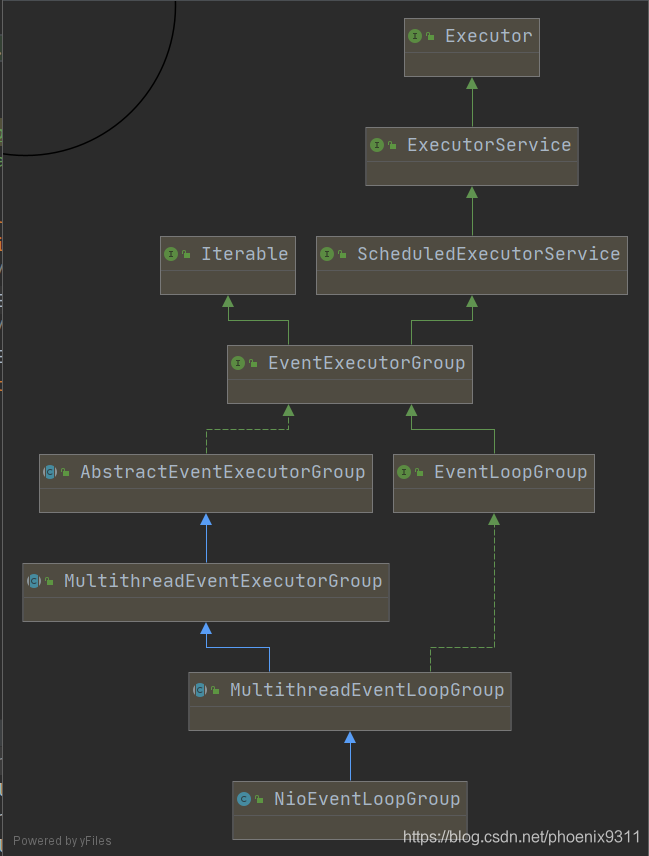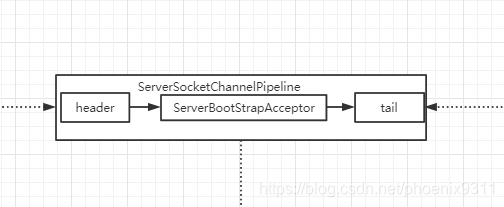Netty线程模型图

源码执行过程流程图

Netty服务端代码
// 管理连接线程组
EventLoopGroup bossGroup = new NioEventLoopGroup(1);
// 处理io任务线程组
EventLoopGroup workerGroup = new NioEventLoopGroup();
try {
// 启动服务端
ServerBootstrap serverBootstrap = new ServerBootstrap();
serverBootstrap.group(bossGroup, workerGroup)
.channel(NioServerSocketChannel.class)
// 等待队列
.option(ChannelOption.SO_BACKLOG,1024)
// 创建通道初始化对象,设置初始化参数
.childHandler(new ChannelInitializer<SocketChannel>() {
@Override
protected void initChannel(SocketChannel ch) throws Exception {
// 给worker group的channel设置处理器
ch.pipeline().addLast(new NettyServerHandler());
ch.pipeline().addLast(new Server2Handler());
ch.pipeline().addLast(new Server3Handler());
}
});
// 启动服务并绑定端口
ChannelFuture channelFuture = serverBootstrap.bind(9000).sync();
System.out.println("netty server start ...");
// 监听通道关闭
channelFuture.channel().closeFuture().sync();
} catch (InterruptedException e) {
e.printStackTrace();
} finally {
bossGroup.shutdownGracefully();
workerGroup.shutdownGracefully();
}
EventLoopGroup继承关系

NioServerSocketChannel继承关系

1.创建线程组
创建两个类型为NioEventLoopGroup的线程组,一个用于处理客户端的连接事件,起名为bossGroup,一个用于处理客户端的读写请求,起名为workerGroup
从父类MultithreadEventLoopGroup的构造方法可以看到优先会使用用户指定的线程,如果不指定会使用默认的线程数
protected MultithreadEventLoopGroup(int nThreads, Executor executor, Object... args) {
super(nThreads == 0 ? DEFAULT_EVENT_LOOP_THREADS : nThreads, executor, args);
}
在静态代码块里,会初始化默认线程数,可以看出来是先取io.netty.eventLoopThreads属性配置的值,如果没有配置则默认是取可用CPU的2倍
private static final int DEFAULT_EVENT_LOOP_THREADS;
static {
DEFAULT_EVENT_LOOP_THREADS = Math.max(1, SystemPropertyUtil.getInt(
"io.netty.eventLoopThreads", NettyRuntime.availableProcessors() * 2));
if (logger.isDebugEnabled()) {
logger.debug("-Dio.netty.eventLoopThreads: {}", DEFAULT_EVENT_LOOP_THREADS);
}
}
从构造方法一路往上追溯到MultithreadEventExecutorGroup的构造方法中(部分异常处理代码有删减)
protected MultithreadEventExecutorGroup(int nThreads, Executor executor,
EventExecutorChooserFactory chooserFactory, Object... args) {
if (executor == null) {
executor = new ThreadPerTaskExecutor(newDefaultThreadFactory());
}
children = new EventExecutor[nThreads];
for (int i = 0; i < nThreads; i ++) {
boolean success = false;
try {
children[i] = newChild(executor, args);
success = true;
}
chooser = chooserFactory.newChooser(children);
}
可以看到这里初始化了一个属性名为children的EventExecutor数组,里面每个对象都有newChild方法来初始化,实际上是创建了一个NioEventLoop对象
protected EventLoop newChild(Executor executor, Object... args) throws Exception {
EventLoopTaskQueueFactory queueFactory = args.length == 4 ? (EventLoopTaskQueueFactory) args[3] : null;
return new NioEventLoop(this, executor, (SelectorProvider) args[0],
((SelectStrategyFactory) args[1]).newSelectStrategy(), (RejectedExecutionHandler) args[2], queueFactory);
}
内部创建了seletor和taskQueue等
NioEventLoop(NioEventLoopGroup parent, Executor executor, SelectorProvider selectorProvider,
SelectStrategy strategy, RejectedExecutionHandler rejectedExecutionHandler,
EventLoopTaskQueueFactory queueFactory) {
super(parent, executor, false, newTaskQueue(queueFactory), newTaskQueue(queueFactory),
rejectedExecutionHandler);
this.provider = ObjectUtil.checkNotNull(selectorProvider, "selectorProvider");
this.selectStrategy = ObjectUtil.checkNotNull(strategy, "selectStrategy");
final SelectorTuple selectorTuple = openSelector();
this.selector = selectorTuple.selector;
this.unwrappedSelector = selectorTuple.unwrappedSelector;
}
protected SingleThreadEventLoop(EventLoopGroup parent, Executor executor,
boolean addTaskWakesUp, Queue<Runnable> taskQueue, Queue<Runnable> tailTaskQueue,
RejectedExecutionHandler rejectedExecutionHandler) {
super(parent, executor, addTaskWakesUp, taskQueue, rejectedExecutionHandler);
tailTasks = ObjectUtil.checkNotNull(tailTaskQueue, "tailTaskQueue");
}
2.构建ServerBootStrap对象
构造方法是空实现,不做任何处理
private final Map<ChannelOption<?>, Object> childOptions = new LinkedHashMap<ChannelOption<?>, Object>();
private final Map<AttributeKey<?>, Object> childAttrs = new ConcurrentHashMap<AttributeKey<?>, Object>();
private final ServerBootstrapConfig config = new ServerBootstrapConfig(this);
private volatile EventLoopGroup childGroup;
private volatile ChannelHandler childHandler;
public ServerBootstrap() { }
通过group方法把bossGroup赋值给group字段,workerGroup赋值childGroup字段
public ServerBootstrap group(EventLoopGroup parentGroup, EventLoopGroup childGroup) {
super.group(parentGroup);
if (this.childGroup != null) {
throw new IllegalStateException("childGroup set already");
}
this.childGroup = ObjectUtil.checkNotNull(childGroup, "childGroup");
return this;
}
通过channel方法给channelFactory属性指定Channel工厂,后续通过无参构造方法来反射创建实例
public B channel(Class<? extends C> channelClass) {
return channelFactory(new ReflectiveChannelFactory<C>(
ObjectUtil.checkNotNull(channelClass, "channelClass")
));
}
public ReflectiveChannelFactory(Class<? extends T> clazz) {
ObjectUtil.checkNotNull(clazz, "clazz");
try {
this.constructor = clazz.getConstructor();
} catch (NoSuchMethodException e) {
throw new IllegalArgumentException("Class " + StringUtil.simpleClassName(clazz) +
" does not have a public non-arg constructor", e);
}
}@Override
public T newChannel() {
try {
return constructor.newInstance();
} catch (Throwable t) {
throw new ChannelException("Unable to create Channel from class " + constructor.getDeclaringClass(), t);
}
}
通过option方法配置参数
public <T> B option(ChannelOption<T> option, T value) {
ObjectUtil.checkNotNull(option, "option");
synchronized (options) {
if (value == null) {
options.remove(option);
} else {
options.put(option, value);
}
}
return self();
}
新建一个ChannelInitializer赋值给childHandler属性,后面启动的时候会用到,暂时先跳过。内部实现就是一个简单的赋值,这里记录一下具体的调用
.childHandler(new ChannelInitializer<SocketChannel>() {
@Override
protected void initChannel(SocketChannel ch) throws Exception {
// 给worker group的channel设置处理器
ch.pipeline().addLast(new NettyServerHandler());
ch.pipeline().addLast(new Server2Handler());
ch.pipeline().addLast(new Server3Handler());
}
});
3.启动服务并绑定端口
serverBootstrap.bind(9000).sync()
沿着方法的调用进入到AbstractBootstrap#doBind方法,这里有两个方法比较重要,一个是initAndRegister(),另外一个是doBind0(regFuture, channel, localAddress, promise)
其中doBind方法比较简单,里面没有什么很复杂的逻辑,最终是调用java的api sun.nio.ch.ServerSocketChannelImpl#bind来实现的,这里我们主要看一下initAndRegister方法
initAndRegister
final ChannelFuture initAndRegister() {
Channel channel = null;
try {
channel = channelFactory.newChannel();
init(channel);
} catch (Throwable t) {
if (channel != null) {
// channel can be null if newChannel crashed (eg SocketException("too many open files"))
channel.unsafe().closeForcibly();
// as the Channel is not registered yet we need to force the usage of the GlobalEventExecutor
return new DefaultChannelPromise(channel, GlobalEventExecutor.INSTANCE).setFailure(t);
}
// as the Channel is not registered yet we need to force the usage of the GlobalEventExecutor
return new DefaultChannelPromise(new FailedChannel(), GlobalEventExecutor.INSTANCE).setFailure(t);
}
ChannelFuture regFuture = config().group().register(channel);
if (regFuture.cause() != null) {
if (channel.isRegistered()) {
channel.close();
} else {
channel.unsafe().closeForcibly();
}
}
return regFuture;
}
这里我们从三个分支分别去看他的调用方向:channelFactory.newChannel()、init(channel)、config().group().register(channel)
3.1channelFactory.newChannel()----新建ServerSocketChannel对象
第二步我们构建ServerBootstrap对象的时候给channelFactory属性赋值的是一个反射创建NioServerSocketChannel对象的工厂,所以这里我们调用new Channel会通过它的无参构造方法反射创建一个NioServerSocketChannel对象
public NioServerSocketChannel() {
this(newSocket(DEFAULT_SELECTOR_PROVIDER));
}
new Socket方法会通过默认的SelectProvider来new 一个java nio包下的ServerSocketChannel对象,进入this方法
public NioServerSocketChannel(ServerSocketChannel channel) {
super(null, channel, SelectionKey.OP_ACCEPT);
config = new NioServerSocketChannelConfig(this, javaChannel().socket());
}
NioServerSocketChannelConfig没什么逻辑,就是把当前对象(NioServerSocketChannel)和ServerSocketChannel的socket封装了一下,接下来进入super
一直进到AbstractNioChannel的构造方法,可以看到当前channel设置了对OP_ACCEPT事件感兴趣,并且配置了非阻塞
protected AbstractNioChannel(Channel parent, SelectableChannel ch, int readInterestOp) {
super(parent);
this.ch = ch;
this.readInterestOp = readInterestOp;
try {
ch.configureBlocking(false);
} catch (IOException e) {
try {
ch.close();
} catch (IOException e2) {
logger.warn(
"Failed to close a partially initialized socket.", e2);
}
throw new ChannelException("Failed to enter non-blocking mode.", e);
}
}
再往上进入父类的构造方法,这里新建了一个unsafe对象,因为这里最终的实现类是NioServerSocketChannel,通过UML结构图可以看出来他最终调用的实现类是AbstractNioMessageChannel#newUnsafe,所以这里的unsafe对象是NioMessageUnsafe对象。
protected AbstractChannel(Channel parent) {
this.parent = parent;
id = newId();
unsafe = newUnsafe();
pipeline = newChannelPipeline();
}
这里还初始化了一个ChannelPipeline对象,里面是由ChannelHandlerContext组成的双向链表,context里面放的是channelHandler对象,现在里面只有head和tail

protected DefaultChannelPipeline(Channel channel) {
this.channel = ObjectUtil.checkNotNull(channel, "channel");
succeededFuture = new SucceededChannelFuture(channel, null);
voidPromise = new VoidChannelPromise(channel, true);
tail = new TailContext(this);
head = new HeadContext(this);
head.next = tail;
tail.prev = head;
}
3.2 init(channel)---Channel初始化
void init(Channel channel) {
setChannelOptions(channel, newOptionsArray(), logger);
setAttributes(channel, attrs0().entrySet().toArray(EMPTY_ATTRIBUTE_ARRAY));
ChannelPipeline p = channel.pipeline();
final EventLoopGroup currentChildGroup = childGroup;
final ChannelHandler currentChildHandler = childHandler;
final Entry<ChannelOption<?>, Object>[] currentChildOptions;
synchronized (childOptions) {
currentChildOptions = childOptions.entrySet().toArray(EMPTY_OPTION_ARRAY);
}
final Entry<AttributeKey<?>, Object>[] currentChildAttrs = childAttrs.entrySet().toArray(EMPTY_ATTRIBUTE_ARRAY);
p.addLast(new ChannelInitializer<Channel>() {
@Override
public void initChannel(final Channel ch) {
final ChannelPipeline pipeline = ch.pipeline();
ChannelHandler handler = config.handler();
if (handler != null) {
pipeline.addLast(handler);
}
ch.eventLoop().execute(new Runnable() {
@Override
public void run() {
pipeline.addLast(new ServerBootstrapAcceptor(
ch, currentChildGroup, currentChildHandler, currentChildOptions, currentChildAttrs));
}
});
}
});
}
这里先是设置了attr和options,childGroup就是我们定义的workerGroup,childHandler就是我们自定义的匿名ChannelInitializer对象,最后向我们上面初始化的ServerSocketChannel的pipeline对象中加入了一个匿名ChannelInitializer对象
我们看一下addLast方法,可以看到这里先是把handler包装了一个channelHandlerContext然后听过addLast0方法加入pipeline
public final ChannelPipeline addLast(EventExecutorGroup group, String name, ChannelHandler handler) {
final AbstractChannelHandlerContext newCtx;
synchronized (this) {
checkMultiplicity(handler);
newCtx = newContext(group, filterName(name, handler), handler);
addLast0(newCtx);
// If the registered is false it means that the channel was not registered on an eventLoop yet.
// In this case we add the context to the pipeline and add a task that will call
// ChannelHandler.handlerAdded(...) once the channel is registered.
if (!registered) {
newCtx.setAddPending();
callHandlerCallbackLater(newCtx, true);
return this;
}
EventExecutor executor = newCtx.executor();
if (!executor.inEventLoop()) {
callHandlerAddedInEventLoop(newCtx, executor);
return this;
}
}
callHandlerAdded0(newCtx);
return this;
}
addLast0方法,可以看出来我们并不是真的加到链表的最后面,而是加到tail的前面一个
private void addLast0(AbstractChannelHandlerContext newCtx) {
AbstractChannelHandlerContext prev = tail.prev;
newCtx.prev = prev;
newCtx.next = tail;
prev.next = newCtx;
tail.prev = newCtx;
}
加入了一个ChannelInitializer对象以后,现在ServerSocketChannel的pipeline里面是这个样子

在ServerSocketChannel注册到selector上的时候,会调用这里的ChannelInitializer对象里面的initChannel方法,具体的触发时间和调用逻辑在后面触发的时候再看
3.3config().group().register(channel)
这里的config()返回的是新建ServerBootStrap对象的时候新建的包含this的ServerBootStrapConfig对象,config().group返回的是ServerBootStrap的group对象,也就是我们初始化的时候新建的bossGroup,从这里暂时可以看出是要把channel注册到bossGroup上面。因为bossGroup是NioEventLoopGroup类型的,根据UML类图可以看出这里调用的是MultithreadEventLoopGroup的register方法,
@Override
public ChannelFuture register(Channel channel) {
return next().register(channel);
}
next()是根据对应的策略选择出bossGroup里面的某一个NioEventLoop,根据uml类图来判断调用逻辑
@Override
public ChannelFuture register(Channel channel) {
return register(new DefaultChannelPromise(channel, this));
}
@Override
public ChannelFuture register(final ChannelPromise promise) {
ObjectUtil.checkNotNull(promise, "promise");
promise.channel().unsafe().register(this, promise);
return promise;
}
promise.channel()返回的就是我们传进来的serverSocketChannel对象,unsafe方法就是new serverSocketChannel对象时创建的NioMessageUnsafe对象(参考3.1)
public final void register(EventLoop eventLoop, final ChannelPromise promise) {
ObjectUtil.checkNotNull(eventLoop, "eventLoop");
if (isRegistered()) {
promise.setFailure(new IllegalStateException("registered to an event loop already"));
return;
}
if (!isCompatible(eventLoop)) {
promise.setFailure(
new IllegalStateException("incompatible event loop type: " + eventLoop.getClass().getName()));
return;
}
AbstractChannel.this.eventLoop = eventLoop;
if (eventLoop.inEventLoop()) {
register0(promise);
} else {
try {
eventLoop.execute(new Runnable() {
@Override
public void run() {
register0(promise);
}
});
} catch (Throwable t) {
logger.warn(
"Force-closing a channel whose registration task was not accepted by an event loop: {}",
AbstractChannel.this, t);
closeForcibly();
closeFuture.setClosed();
safeSetFailure(promise, t);
}
}
}
当前运行的是main线程,并不是NioEventLoop里面的线程,所以这里会走else逻辑
eventLoop.execute(new Runnable() {
@Override
public void run() {
register0(promise);
}
});
这里分成两个部分分别来看
3.3.1 eventLoop.execute
private void execute(Runnable task, boolean immediate) {
boolean inEventLoop = inEventLoop();
addTask(task);
if (!inEventLoop) {
startThread();
if (isShutdown()) {
boolean reject = false;
try {
if (removeTask(task)) {
reject = true;
}
} catch (UnsupportedOperationException e) {
// The task queue does not support removal so the best thing we can do is to just move on and
// hope we will be able to pick-up the task before its completely terminated.
// In worst case we will log on termination.
}
if (reject) {
reject();
}
}
}
if (!addTaskWakesUp && immediate) {
wakeup(inEventLoop);
}
}
这里先把register0这个任务放到taskQueue里面等待异步执行,
final boolean offerTask(Runnable task) {
if (isShutdown()) {
reject();
}
return taskQueue.offer(task);
}
同样的因为这里是main线程会走if条件里面的逻辑,执行启动线程startThread方法
CAS设置启动状态,然后执行doStartThread方法
private void startThread() {
if (state == ST_NOT_STARTED) {
if (STATE_UPDATER.compareAndSet(this, ST_NOT_STARTED, ST_STARTED)) {
boolean success = false;
try {
doStartThread();
success = true;
} finally {
if (!success) {
STATE_UPDATER.compareAndSet(this, ST_STARTED, ST_NOT_STARTED);
}
}
}
}
}
这里使用线程池去执行后面的任务,main线程会立刻返回,我们来看线程内部执行的任务(视角从main线程切换到线程池上的线程)
private void doStartThread() {
assert thread == null;
executor.execute(new Runnable() {
@Override
public void run() {
thread = Thread.currentThread();
if (interrupted) {
thread.interrupt();
}
boolean success = false;
updateLastExecutionTime();
try {
SingleThreadEventExecutor.this.run();
success = true;
}
我们这里看主流程SingleThreadEventExecutor.this.run(),其他的异常处理和状态流转先忽略。
protected void run() {
int selectCnt = 0;
for (;;) {
try {
int strategy;
try {
strategy = selectStrategy.calculateStrategy(selectNowSupplier, hasTasks());
switch (strategy) {
case SelectStrategy.CONTINUE:
continue;
case SelectStrategy.BUSY_WAIT:
// fall-through to SELECT since the busy-wait is not supported with NIO
case SelectStrategy.SELECT:
long curDeadlineNanos = nextScheduledTaskDeadlineNanos();
if (curDeadlineNanos == -1L) {
curDeadlineNanos = NONE; // nothing on the calendar
}
nextWakeupNanos.set(curDeadlineNanos);
try {
if (!hasTasks()) {
strategy = select(curDeadlineNanos);
}
} finally {
// This update is just to help block unnecessary selector wakeups
// so use of lazySet is ok (no race condition)
nextWakeupNanos.lazySet(AWAKE);
}
// fall through
default:
}
} catch (IOException e) {
// If we receive an IOException here its because the Selector is messed up. Let's rebuild
// the selector and retry. https://github.com/netty/netty/issues/8566
rebuildSelector0();
selectCnt = 0;
handleLoopException(e);
continue;
}
selectCnt++;
cancelledKeys = 0;
needsToSelectAgain = false;
final int ioRatio = this.ioRatio;
boolean ranTasks;
if (ioRatio == 100) {
try {
if (strategy > 0) {
processSelectedKeys();
}
} finally {
// Ensure we always run tasks.
ranTasks = runAllTasks();
}
} else if (strategy > 0) {
final long ioStartTime = System.nanoTime();
try {
processSelectedKeys();
} finally {
// Ensure we always run tasks.
final long ioTime = System.nanoTime() - ioStartTime;
ranTasks = runAllTasks(ioTime * (100 - ioRatio) / ioRatio);
}
} else {
ranTasks = runAllTasks(0); // This will run the minimum number of tasks
}
if (ranTasks || strategy > 0) {
if (selectCnt > MIN_PREMATURE_SELECTOR_RETURNS && logger.isDebugEnabled()) {
logger.debug("Selector.select() returned prematurely {} times in a row for Selector {}.",
selectCnt - 1, selector);
}
selectCnt = 0;
} else if (unexpectedSelectorWakeup(selectCnt)) { // Unexpected wakeup (unusual case)
selectCnt = 0;
}
} catch (CancelledKeyException e) {
// Harmless exception - log anyway
if (logger.isDebugEnabled()) {
logger.debug(CancelledKeyException.class.getSimpleName() + " raised by a Selector {} - JDK bug?",
selector, e);
}
} catch (Throwable t) {
handleLoopException(t);
}
// Always handle shutdown even if the loop processing threw an exception.
try {
if (isShuttingDown()) {
closeAll();
if (confirmShutdown()) {
return;
}
}
} catch (Throwable t) {
handleLoopException(t);
}
}
}
可以看到NioEventLoop启动的这个线程,for死循环执行这段逻辑,第一次循环的时候,此时taskQueue里面是有刚才加入的register0的这个任务,所以hastask()方法返回true,此时selector上并没有connect或读写事件(netty服务端还没启动完成),所以strategy的值为0;switch内部没有任何操作,此时ioRatio为初始值50,所以会进入到runAllTasks方法
runAllTasks
执行任务队列中的所有任务,此时任务队列中只有一个任务,就是刚才加入的register0
protected boolean runAllTasks(long timeoutNanos) {
fetchFromScheduledTaskQueue();
Runnable task = pollTask();
if (task == null) {
afterRunningAllTasks();
return false;
}
final long deadline = timeoutNanos > 0 ? ScheduledFutureTask.nanoTime() + timeoutNanos : 0;
long runTasks = 0;
long lastExecutionTime;
for (;;) {
safeExecute(task);
runTasks ++;
// Check timeout every 64 tasks because nanoTime() is relatively expensive.
// XXX: Hard-coded value - will make it configurable if it is really a problem.
if ((runTasks & 0x3F) == 0) {
lastExecutionTime = ScheduledFutureTask.nanoTime();
if (lastExecutionTime >= deadline) {
break;
}
}
task = pollTask();
if (task == null) {
lastExecutionTime = ScheduledFutureTask.nanoTime();
break;
}
}
afterRunningAllTasks();
this.lastExecutionTime = lastExecutionTime;
return true;
}
3.3.2 register0(promise);
doRegister方法把ServerSocketChannel注册到bossGroup里面的某一个NioEventLoop上的unwrappedSelector上
private void register0(ChannelPromise promise) {
try {
// check if the channel is still open as it could be closed in the mean time when the register
// call was outside of the eventLoop
if (!promise.setUncancellable() || !ensureOpen(promise)) {
return;
}
boolean firstRegistration = neverRegistered;
doRegister();
neverRegistered = false;
registered = true;
// Ensure we call handlerAdded(...) before we actually notify the promise. This is needed as the
// user may already fire events through the pipeline in the ChannelFutureListener.
pipeline.invokeHandlerAddedIfNeeded();
safeSetSuccess(promise);
pipeline.fireChannelRegistered();
// Only fire a channelActive if the channel has never been registered. This prevents firing
// multiple channel actives if the channel is deregistered and re-registered.
if (isActive()) {
if (firstRegistration) {
pipeline.fireChannelActive();
} else if (config().isAutoRead()) {
// This channel was registered before and autoRead() is set. This means we need to begin read
// again so that we process inbound data.
//
// See https://github.com/netty/netty/issues/4805
beginRead();
}
}
} catch (Throwable t) {
// Close the channel directly to avoid FD leak.
closeForcibly();
closeFuture.setClosed();
safeSetFailure(promise, t);
}
}
接下来调用pipeline中的invokeHandlerAddedIfNeeded方法,此时的pipeline是这个样子的(参照3.2末尾)

从pendingHandlerCallbackHead开始通过链表依次调用execute方法,此时链表里面只有一个对象,因为pipeline里面只有一个handler(除header和tail)
private void callHandlerAddedForAllHandlers() {
final PendingHandlerCallback pendingHandlerCallbackHead;
synchronized (this) {
assert !registered;
// This Channel itself was registered.
registered = true;
pendingHandlerCallbackHead = this.pendingHandlerCallbackHead;
// Null out so it can be GC'ed.
this.pendingHandlerCallbackHead = null;
}
// This must happen outside of the synchronized(...) block as otherwise handlerAdded(...) may be called while
// holding the lock and so produce a deadlock if handlerAdded(...) will try to add another handler from outside
// the EventLoop.
PendingHandlerCallback task = pendingHandlerCallbackHead;
while (task != null) {
task.execute();
task = task.next;
}
}
pendingHandlerCallbackHead对象是什么?从哪里初始化的?
在3.2中channel初始化的时候,向pipeline中新增了一个ChannelInitializer对象,执行addLast方法的时候,因为channel还没有注册到bossGroup中的nioEventloop的selector上,所以走了if的逻辑
if (!registered) {
newCtx.setAddPending();
callHandlerCallbackLater(newCtx, true);
return this;
}
执行callHandlerCallbackLater方法
新建一个PendingHandlerAddedTask对象,加在链表的末尾。这个对象继承自runnable,内部封装了channelHandlerContext属性.
所以这个时候链表里面只有一个PendingHandlerAddedTask对象,对应的channelHandlerContext内部封装了ChannelInitializer对象(ChannelHandler子类)
private void callHandlerCallbackLater(AbstractChannelHandlerContext ctx, boolean added) {
assert !registered;
PendingHandlerCallback task = added ? new PendingHandlerAddedTask(ctx) : new PendingHandlerRemovedTask(ctx);
PendingHandlerCallback pending = pendingHandlerCallbackHead;
if (pending == null) {
pendingHandlerCallbackHead = task;
} else {
// Find the tail of the linked-list.
while (pending.next != null) {
pending = pending.next;
}
pending.next = task;
}
}
所以上面的task.execute方法最终是调用PendingHandlerAddedTask.execute方法
@Override
void execute() {
EventExecutor executor = ctx.executor();
if (executor.inEventLoop()) {
callHandlerAdded0(ctx);
} else {
try {
executor.execute(this);
} catch (RejectedExecutionException e) {
if (logger.isWarnEnabled()) {
logger.warn(
"Can't invoke handlerAdded() as the EventExecutor {} rejected it, removing handler {}.",
executor, ctx.name(), e);
}
atomicRemoveFromHandlerList(ctx);
ctx.setRemoved();
}
}
}
不论是哪个线程在执行,最终都是进入callHandlerAdded0方法 => ctx.callHandlerAdded() => handler().handlerAdded(this)
因为这里的handler最终实现是ChannelInitializer对象,所以进入对应的方法如下:
public void handlerAdded(ChannelHandlerContext ctx) throws Exception {
if (ctx.channel().isRegistered()) {
// This should always be true with our current DefaultChannelPipeline implementation.
// The good thing about calling initChannel(...) in handlerAdded(...) is that there will be no ordering
// surprises if a ChannelInitializer will add another ChannelInitializer. This is as all handlers
// will be added in the expected order.
if (initChannel(ctx)) {
// We are done with init the Channel, removing the initializer now.
removeState(ctx);
}
}
}
此时ServerSocketChannel已经注册完成,所以会执行对应的initChannel方法,进入具体实现
private boolean initChannel(ChannelHandlerContext ctx) throws Exception {
if (initMap.add(ctx)) { // Guard against re-entrance.
try {
initChannel((C) ctx.channel());
} catch (Throwable cause) {
// Explicitly call exceptionCaught(...) as we removed the handler before calling initChannel(...).
// We do so to prevent multiple calls to initChannel(...).
exceptionCaught(ctx, cause);
} finally {
ChannelPipeline pipeline = ctx.pipeline();
if (pipeline.context(this) != null) {
pipeline.remove(this);
}
}
return true;
}
return false;
}
可以看出这里会调用ChannelInitializer对象的initChannel方法,从3.2初始化channel可以看到往pipeline中加入了ServerBootstrapAcceptor对象,最终在finally模块中从pipeline删掉自己,所以现在pipeline中是这样的

接着回到register0方法中,回调pipeline中channelHandler的channelRegistered方法,如果channel激活,触发channelActive方法,因为这里唯一的handler(ServerBootstrapAcceptor对象)没有具体实现,所以不深入下去
pipeline.fireChannelRegistered();
此时SingleThreadEventExecutor.this.run()方法内部死循环还在执行,服务端已经启动成功了,客户端还没有启动,所以方法会阻塞在selector.select上等待客户端连接和写数据,接下来我们启动客户端
启动客户端会接收到连接请求,服务端进入processSelectedKeys方法处理
private void processSelectedKeys() {
if (selectedKeys != null) {
processSelectedKeysOptimized();
} else {
processSelectedKeysPlain(selector.selectedKeys());
}
}
当有connect或read/write事件发生时,selectedKeys不为null,执行processSelectedKeysOptimized方法,for循环处理每一个连接事件
private void processSelectedKeysOptimized() {
for (int i = 0; i < selectedKeys.size; ++i) {
final SelectionKey k = selectedKeys.keys[i];
// null out entry in the array to allow to have it GC'ed once the Channel close
// See https://github.com/netty/netty/issues/2363
selectedKeys.keys[i] = null;
final Object a = k.attachment();
if (a instanceof AbstractNioChannel) {
processSelectedKey(k, (AbstractNioChannel) a);
} else {
@SuppressWarnings("unchecked")
NioTask<SelectableChannel> task = (NioTask<SelectableChannel>) a;
processSelectedKey(k, task);
}
if (needsToSelectAgain) {
// null out entries in the array to allow to have it GC'ed once the Channel close
// See https://github.com/netty/netty/issues/2363
selectedKeys.reset(i + 1);
selectAgain();
i = -1;
}
}
}
接着进入processSelectedKey方法 如果是connect事件,完成连接,建立socketChannel通道,如果是write事件,写完数据flush缓冲区
private void processSelectedKey(SelectionKey k, AbstractNioChannel ch) {
final AbstractNioChannel.NioUnsafe unsafe = ch.unsafe();
if (!k.isValid()) {
final EventLoop eventLoop;
try {
eventLoop = ch.eventLoop();
} catch (Throwable ignored) {
return;
}
if (eventLoop == this) {
unsafe.close(unsafe.voidPromise());
}
return;
}
try {
int readyOps = k.readyOps();
if ((readyOps & SelectionKey.OP_CONNECT) != 0) {
int ops = k.interestOps();
ops &= ~SelectionKey.OP_CONNECT;
k.interestOps(ops);
unsafe.finishConnect();
}
if ((readyOps & SelectionKey.OP_WRITE) != 0) {
ch.unsafe().forceFlush();
}
if ((readyOps & (SelectionKey.OP_READ | SelectionKey.OP_ACCEPT)) != 0 || readyOps == 0) {
unsafe.read();
}
} catch (CancelledKeyException ignored) {
unsafe.close(unsafe.voidPromise());
}
}
因为我们这里的channel是serverSocketChannel,所以我们主要看read和accept事件,进入unsafe.read方法
public void read() {
assert eventLoop().inEventLoop();
final ChannelConfig config = config();
final ChannelPipeline pipeline = pipeline();
final RecvByteBufAllocator.Handle allocHandle = unsafe().recvBufAllocHandle();
allocHandle.reset(config);
boolean closed = false;
Throwable exception = null;
try {
try {
do {
int localRead = doReadMessages(readBuf);
if (localRead == 0) {
break;
}
if (localRead < 0) {
closed = true;
break;
}
allocHandle.incMessagesRead(localRead);
} while (allocHandle.continueReading());
} catch (Throwable t) {
exception = t;
}
int size = readBuf.size();
for (int i = 0; i < size; i ++) {
readPending = false;
pipeline.fireChannelRead(readBuf.get(i));
}
readBuf.clear();
allocHandle.readComplete();
pipeline.fireChannelReadComplete();
if (exception != null) {
closed = closeOnReadError(exception);
pipeline.fireExceptionCaught(exception);
}
if (closed) {
inputShutdown = true;
if (isOpen()) {
close(voidPromise());
}
}
} finally {
// Check if there is a readPending which was not processed yet.
// This could be for two reasons:
// * The user called Channel.read() or ChannelHandlerContext.read() in channelRead(...) method
// * The user called Channel.read() or ChannelHandlerContext.read() in channelReadComplete(...) method
//
// See https://github.com/netty/netty/issues/2254
if (!readPending && !config.isAutoRead()) {
removeReadOp();
}
}
}
我们首先来看doReadMessages方法,接收客户端连接生成SocketChannel建立连接,然后封装NioSocketChannel对象,加入到buf里面
protected int doReadMessages(List<Object> buf) throws Exception {
SocketChannel ch = SocketUtils.accept(javaChannel());
try {
if (ch != null) {
buf.add(new NioSocketChannel(this, ch));
return 1;
}
} catch (Throwable t) {
logger.warn("Failed to create a new channel from an accepted socket.", t);
try {
ch.close();
} catch (Throwable t2) {
logger.warn("Failed to close a socket.", t2);
}
}
return 0;
}
NioSocketChannel对象初始化过程和NioServerSocketChannel对象类似,此时对象内部也有一个初始化的pipeline

接下来执行pipeline的fireChannelRead方法,注意这里的pipeline是serverSocketChannel里面的pipeline,参数readbuf.get(i)是刚才建立连接的NioSocketChannel,此时pipeline里面只有一个ServerBootStrapAcceptor对象,所以我们直接看这个对象的channelRead方法
public void channelRead(ChannelHandlerContext ctx, Object msg) {
final Channel child = (Channel) msg;
child.pipeline().addLast(childHandler);
setChannelOptions(child, childOptions, logger);
setAttributes(child, childAttrs);
try {
childGroup.register(child).addListener(new ChannelFutureListener() {
@Override
public void operationComplete(ChannelFuture future) throws Exception {
if (!future.isSuccess()) {
forceClose(child, future.cause());
}
}
});
} catch (Throwable t) {
forceClose(child, t);
}
}
可以看到这里先向NioSocketChannel的pipeline中加入了childHandler,就是最前面我们自己自定义的ChannelInitializer对象,里面写了业务处理逻辑流程。接下来设置attr和options。
最关键的一点,我们这里发现NioSocketChannel被注册到了childGroup上(也就是workerGroup上)。注册过程和前面相同,只不过换了一个group,这里就不赘述了。
最后如果客户端向服务端写数据,workerGroup上的NioEventLoop的selector探测到了,还是调用前面的unsafe.read方法,不过这里的channel是NioSocketChannel,所以对应的unsafe对象换成了NioByteUnsafe,所以实现逻辑换成了如下,触发pipeline上的channelHandler的channelRead方法和fireChannelReadComplete方法,最终调用我们写的业务逻辑
do {
byteBuf = allocHandle.allocate(allocator);
allocHandle.lastBytesRead(doReadBytes(byteBuf));
if (allocHandle.lastBytesRead() <= 0) {
// nothing was read. release the buffer.
byteBuf.release();
byteBuf = null;
close = allocHandle.lastBytesRead() < 0;
if (close) {
// There is nothing left to read as we received an EOF.
readPending = false;
}
break;
}
allocHandle.incMessagesRead(1);
readPending = false;
pipeline.fireChannelRead(byteBuf);
byteBuf = null;
} while (allocHandle.continueReading());
allocHandle.readComplete();
pipeline.fireChannelReadComplete();
if (close) {
closeOnRead(pipeline);
}






















 530
530

 被折叠的 条评论
为什么被折叠?
被折叠的 条评论
为什么被折叠?








